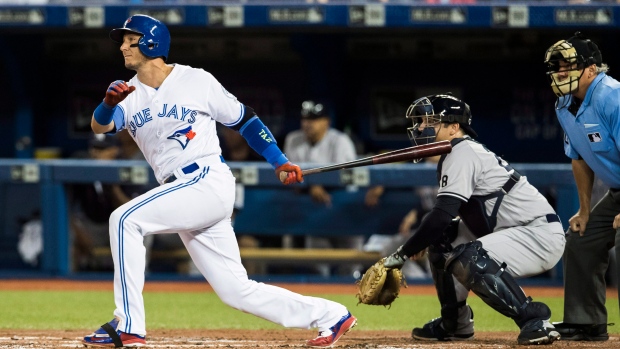Oct 15, 2016
Tulowitzki should precede Martin in Jays' order
As the Jays find themselves down 0-1 against the rolling Cleveland Indians, questions on why a cold Russell Martin is batting before a hot Troy Tulowitzki propagate. As TSN Baseball Analyst Dirk Hayhurst writes, it's now time to move Tulowitzki ahead of Martin in the batting lineup.

As the Toronto Blue Jays find themselves down 0-1 against the rolling Cleveland Indians, thanks in large to their inability to drive in runners against the formidable Corey Kluber, questions on why a cold Russell Martin is batting before a hot Troy Tulowitzki propagate.
Martin is an abysmal 1-20 this postseason, a postseason that is little more than a five game stretch of time wherein the Jays launched 10 home runs and knocked out every starting pitcher they’ve faced before the fifth inning, save for Kluber. Martin had the chance to continue that streak twice on Friday in Game 1 of the ALCS, but couldn’t deliver.
When you look at the case to move up Tulo into Martin’s spot, It’s an easy decision. Tulo is hitting .353 this postseason with five RBIs. In fact, keeping the order the way it is is defensible only because John Gibbons didn’t “feel” he needed to make a change for the sake of preserving what he felt was working.
Except this time it didn’t work.
To his credit, Gibbons’ feelings have served him well. Stroman’s start in the wild-card game was a statistical miss match, but it worked. Martin is cold, but he’s still a good hitter, and the Jays have won up until this point. It was also the ball that Martin put into play that allowed Donaldson to score the clinching run in Game 3 of the ALDS - though, if the Rangers defence wasn’t a train wreck, it could have been a double play.
So, how long to do you go with what’s working and when do you officially decide it’s not? And if you believe your feelings on how an order is set up are just as important as the stats, do you let a bad night against one of baseball’s best pitchers and a small postseason sample size sway you?
I do.
I’ve never been a fan of the argument that comfortable inefficiency is part of the ultimate efficiency. For me, the Jays have won despite Martin more than they’ve benefited from his space in the order appealing to cosmic forces. That’s not to say I don’t think Martin will break out at some point, but he can do that one space further down the order. In fact, he might do it faster one space down where the fastballs are more plentiful.
However, whether the Jays bounce back in Game 2 of the ALCS or not won’t be decided by Martin. It will be decided by J.A. Happ's performance.
Speaking of stranding runners, Happ stranded a heap of them in his ALDS start against Texas. In fact, you could call him an escape artist as he got himself into several jams, only to make big pitches that locked up Texas bats and ultimately got him out of trouble. Some say this was a shaky start by Happ, but I saw it as Happ being Happ. Pitchers get into trouble and great pitchers find ways out of it. Happ has been doing that all season, as evidenced by his 77.2 per cent strand rate, one of the highest in baseball.
Unlike the Rangers, a fastball-hitting club, Happ’s fastball will play even better against the Indians. Of all the teams in baseball, the Indians’ slugging is largely skewed toward offspeed pitches. Their park adjust slugging for fastballs is one of the lowest in the last decade. What does that mean for Happ? Simply that his fastball should serve him well and if he keeps throwing it like he did in the Texas series, there is a better probability that the Indians will struggle with it more than the Rangers.
Happ is hittable, but he’s hard to pile runs on. His opponent, Josh Tomlin, is extremely hittable. In fact, Tomlin has one of baseball’s highest contact rates. He rarely strikes hitters out and relies heavily on soft contact. In short, the Jays should mash him.

